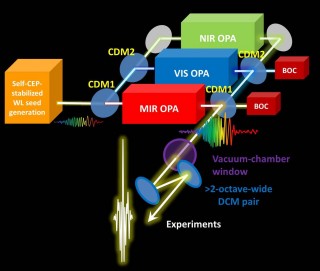Future experiments in attoscience and strong-field physics would profit from ultrafast electromagnetic waveforms sculpted on a sub-optical-cycle time scale. For the first time a group of CUI scientists around Shih-Hsuan Chia could demonstrate dispersion-controlled precision optics covering two octaves, which can withstand several tens of mJ pulse energy. Thus the team succeeded in finding the missing link for high-energy waveform synthesizers that has been sought-after for a very long time. In connection with his results, Shih-Hsuan Chia of the Ultrafast Optics and X-Rays group at CFEL was awarded the prize for the best oral student presentation in the category “sources” at the Advanced Solid-State Lasers Conference (ASSL 2014) in Shanghai.
Many physical processes in attoscience and strong-field physics sensitively depend on the temporal evolution of the laser electric field E(t). So far, most experiments aiming to observe and control such processes have routinely employed a combination of actively carrier-envelope phase (CEP)-stabilized Ti:sapphire chirped-pulse amplifiers and subsequent gas-phase nonlinear pulse compressors to generate intense pulses with few-femtosecond durations.
This well-established technology, however, faces unsurmountable obstacles when trying to further scale up the pulse energy, repetition rate and spectral coverage required for advanced future experiments. Alternatively, parametric waveform synthesizers offer much better prospects for simultaneously scaling up both the pulse energy to the multi-millijoule level and the repetition rate to tens or hundreds of kilohertz. Such prospects make the technology very attractive for next-generation attoscience light sources based on high-order harmonic generation (HHG) such as ELI-ALPS, targeting extreme operating parameters.
 For these reasons, the CFEL Ultrafast Optics & X-Rays (CFEL-UX) group, directed by Prof. Franz X. Kärtner (Universität Hamburg, DESY), in collaboration with the group of Prof. Giulio Cerullo from the Politecnico di Milano has pursued the development of parametric waveform synthesizers as schematically depicted .
For these reasons, the CFEL Ultrafast Optics & X-Rays (CFEL-UX) group, directed by Prof. Franz X. Kärtner (Universität Hamburg, DESY), in collaboration with the group of Prof. Giulio Cerullo from the Politecnico di Milano has pursued the development of parametric waveform synthesizers as schematically depicted .
In their parallel synthesizer architecture, a self-CEP-stabilized white-light seed continuum spanning more than 2 octaves of optical bandwidth is split by chirped dichroic mirrors (CDM1,2) into three parallel optical parametric amplification channels (VIS/NIR/MIR OPA). The amplified outputs from the three channels together yield >2-mJ pulse energy and support ~2-femtosecond pulse duration. To perform the coherent waveform synthesis by recombining the three channels again on the same types of CDMs, the arrival times of the pulses can actively be synchronized with attosecond-level precision using balanced optical cross-correlators (BOCs), that were also previously developed by the Kärtner group.
Now, in their new Optica article, Shih-Hsuan Chia and his CUI colleagues demonstrate the long sought-after missing link: the >2-octave-wide dispersion-controlled precision optics – chirped dichroic mirrors (CDM1,2) and a double-chirped mirror (DCM) pair – that allow them to split andrecombine with almost perfect efficiency as well as to recompress these >2-octave-wide multi-mJ waveforms to ~2-fs duration inside a vacuum chamber housing their attoscience experiments. The dispersion control scheme avoids unwanted Kerr nonlinearities in the substrate of the final CDM1 and the vacuum window, that otherwise would destroy the quality of the waveforms.
Citation:
Chia S.-H., Cirmi G., Fang S., Rossi G. M., Mücke O. D., Kärtner F. X.
“Two-octave-spanning dispersion-controlled precision optics for sub-optical-cycle waveform synthesizers”
Optica, Vol. 1, Issue 5, pp. 315-322 (2014)
DOI: 10.1364/OPTICA.1.000315

